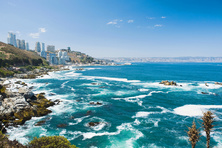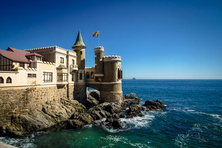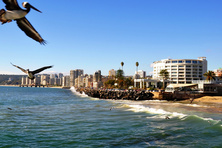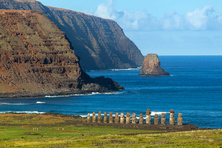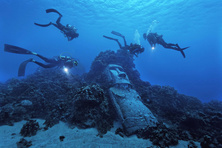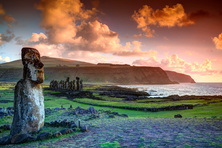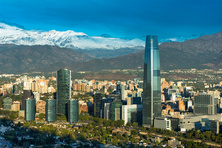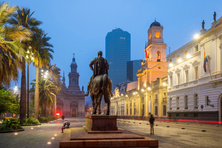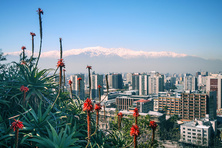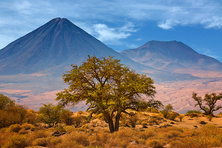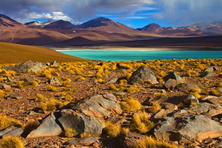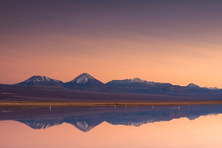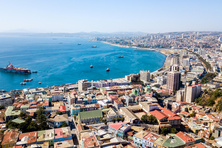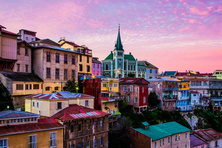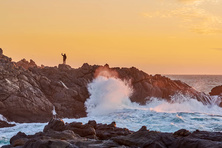Chile
- Capital:Santiago
- Currency: Chilean peso
- Time: UTC-4
- Languages: Spanish
- Religions: Christianity (Catholicism, Protestantism)
- Sections: Get in Visa Customs Cuisine Money Details of interest Popular resorts
Chile is the country in South America situated on a narrow strip of land between the Pacific Ocean and the Andes. It shares its borders with Bolivia, Peru, and Argentina.
Due to its extensive land, the climate is different in different parts of the country. On the north, where the Atacama Desert is situated, the climate is tropical desert. The highest temperature during the daytime can reach +40°C and at night, the temperature can be as low as 0°C. The south of Chile has a subtropical climate with frequent rains in winter. The warmest weather here is in January: the daytime temperature is +30°C and the night temperature is +18°C. The central part of the country has the temperate oceanic climate. In summer, the temperate can reach +24°C and in winter, it is not lower than +18°C.
The majority of the population are the Chileans. The official language is Spanish.
The best for visiting the central part of the country is from September to April. From October to April is the best time for going on excursions in Santiago. In March, we recommend visiting the Easter Island. And it is better to visit the ski resorts Valle Nevado and Portillo from June to October.
The most popular beach resort in Chile is Vina del Mar. It is also called a ‘Garden City’ due to its numerous parks and well-groomed gardens. Another popular beach Arica is situated very close to the Peru border. This place has everything you need for snorkelling, diving or deep underwater fishing. On the north, in the district La Serena, the tourists will find the beaches and places for active water sports. Ecological tourism and hiking are gaining a great popularity.
Get in
By Plane
The most convenient way to get to Chile is a flight. Iberia offers the flights for Russia and European tourists to Santiago through Madrid. The total time of the travel will be about 21 hours.
It will take you two hours less to travel to Santiago from Moscow with a transfer in Paris. Air France offer a flight to the capital city and the flight will take 19 hours.
If a tourist has a valid US visa, he or she can travel to Santiago through New York.
By Bus
There are regular bus routes between Santiago and other South American countries.
Visa
If Russian, CIS and European tourists stay in Chile for 90 days, they can get to the country visa-free. The tourists who are planning a short stay in Chile can get a visa on arrival right at the airport in Santiago.
The tourists should have:
- valid international passport;
- hotel booking confirmation;
- filled migration form;
- return tickets;
- confirmation of financial sufficiency for each person.
If the tourists intend to stay in Chile for over 90 days, they have to obtain a visa beforehand.
Customs
According to the Customs legislation of Chile, the tourists must declare the money exceeding 10.000 US dollars. There are no other restrictions concerning the import or export of national and foreign currency.
The adult travellers can bring in some alcohol and cigarettes.
The tourists can bring in duty-free phones, tablets or computers for personal use. It is allowed to bring in Chile the goods bought in Duty-Free shops, but the total some of the purchase should not exceed 500 US dollars.
It is prohibited to import bee products (wax or honey) and the bees. It is also not allowed to import all types of bacteria, snails, mushrooms, and biological material which can be used as experimental for further scientific research.
The tourists cannot bring in food without a phytosanitary permission. This rule applies also to dried fruits, non-canned meat products, and all dairy products.
Pets can be brought in provided that there is an international vet certificate and a rabies vaccination certificate. The import of animals from the Easter Island requires a special permit. It is strictly prohibited to bring in the parrots.
The tourists are not allowed to export antiquities and other items having artistic or historical value. Certain animals and plants are not allowed for the export either.
Souvenirs made from fur and skin of rare animals and bijouterie made of bones can be exported only if a tourist has a sales receipt.
Cuisine
Almost all Chilean dishes are hot. Garlic, hot pepper, and many spices are typical ingredients for traditional dishes.
A traditional first course in Chile is a soup Cazuela and its various versions. What is unusual about this soup is a way of cooking: the vegetables are added without slicing just as they are. The soup Curanto includes several types of meat, fish and potatoes. If the tourists want something truly exotic, they should try Chitaela, a soup with sea urchin.
The tourists can try a fantastic dish Saltado (vegetable and corn stew) in any eatery. The main dish is often served with Humitas or Tamale, a hot mashed corn in banana or maize leaves.
The lovers of meat should try beef or veal roast beef served with cassava or potatoes Lomo a lo Pobre. A steak Saint Carolina will delight even the pickiest tourists. You will definitely like the Chilean Parillada, a grilled liver dish.
The coastal districts in Chile are famous for their seafood and fish dishes. Manchas a lo parmesana are amazingly delicious clams with cheese.
You cannot leave Chile without trying traditional fruit jams prepared according to the family recipes which they keep secret. Those who have a sweet tooth should definitely treat themselves to fluffy Chilean cinnamon cakes filled with mango and cassava jam.
Mate tea and fresh fruit juices are the most popular non-alcoholic drinks. The Chilean wines are internationally acknowledged. However, the locals themselves prefer Pisco. This is a 40% alcoholic drink made with brandy. It is served with a whipped egg, lemon juice, and ice.
Money
The official currency in Chile is the Chilean Peso.
In Chile, US dollars are willingly accepted.
Banks and exchange offices are the only places in Chile, where the tourists can safely exchange the currency. The tourists can also take advantage of the services of the local people, but their exchange rate is 10% higher. Besides, there is a great risk of a fraud.
Restaurants, hotels, and supermarkets accept VISA, MasterCard or American Express.
In small towns and villages, you can pay only with cash. Cash is the most popular payment method.
You can cash traveller’s checks only in exchange offices. We do not recommend using the services of banks as the transaction takes a lot of time. And the banks work only until noon. The best exchange rate is for checks in US dollars.
Details of interest
Customs and Traditions
The Chileans today are the people of different ethnic groups and each group tries to preserve its own culture, language, and customs.
The Chilean Indians are believed to be too conservative and a bit aggressive to the foreigners but this is just a myth. The locals are very polite and friendly towards the tourists and are always ready to lend them a hand.
Sightseeing in Chile
UNESCO did not overlook the sites in Chile.
- The Rapa Nui national park on the Easter Island is known for its stone sculptures Moai. Since the 4th century, this park is a home for the people of the Polynesian origin. The tourists will love a trip to the island where they will see those unusual monolithic statues forming a unique cultural landscape.
- Eights Catholic Churches of Chiole built in the 17th - 19th centuries by the travelling Jesuits. The churches are the excellent example of the combination of the European and the Chilean cultures.
- The Historic Quarter of the Seaport City of Valparaiso is a very important cultural centre in Chile with its educational institutions. A trip to Valparaiso is a chance to see historical and architectural monuments of the Latin America of the 19th century.
- Humberstone and Santa Laura Saltpeter Works are two former saltpeter refineries. In these towns live people who created their own culture Pampinos. This culture had a great influence on the development of the entire Chilean region.
- The Sewell Minin Town is an important town for the history and culture of the country. Here, the tourists can see the settlement of the miners founded at the beginning of the 20th century. In Sewell lived the workers who were extracting copper in the largest underground mine in the world El Teniente. Because of the mountainous landscape, it was impossible to use the cars and the sites of the town were connected to each other with many wooden stairs.
- The Qhapaq Nan, Andean Road System was built by the Incas. The roads were built through the mountains, rocks, and gorges with the help of the stairs and complicated suspension bridges.
- Between the Andes and the Pacific Ocean, there is a unique San Padro de Atacama desert. The tourists can see the major sources of water in the desert, namely the rivers San Pedro and Vilama.
- On the Chilean mountain range, there is the unique biosphere reserve Torres del Paine and Bernardo O'Higgins National Park. The natural landscape of the park was formed over 11. 000. 000 years ago.
Souvenirs in Chile
The tourists can find traditional souvenirs on the fairs in Santiago and Valdivia.
A sweet reminder of the country is the marzipan gingerbread cookies Alfajores. A good gift for a man is a drink Pisco.
An unusual souvenir from Chile is the species of pepper rocoto, ajo, and merquen.
A traditional souvenir from Chile is a bright poncho with ethnic Chilean patterns.







